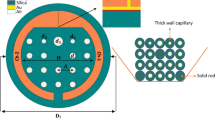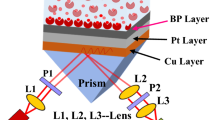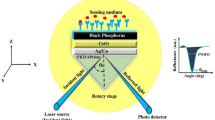Abstract
There are numerous pharmacological uses for watery solution’s sucrose concentration, including the preservation of food and proteins. It is imperative to create a sucrose detector that is quick, precise, and sensitive. In this communication, a surface plasmon resonance biosensor (SPRB) is employed for the determination of sucrose concentration. To achieve improved sensitivity, a Si layer is inserted between a metal (Ag) thin film and a black phosphor (BPS) layer in the proposed SPRB so that it has the design N-FK51A prism/silver/Si/BPS/ sensing medium (SM). Due to the exceptional dielectric properties of the Si layer, which include a high refraction index and low loss, it has been demonstrated that a little change in the analyte’s refractive index can result in a substantial shift in the angle of resonance. By optimizing the thicknesses of the Ag, Si, and BP sheets, the suggested SPRB achieved an extraordinarily high sensitivity of 322.66°/RIU. Due to its great sensitivity, the suggested SPRB is enticing for usage in numerous biosensing applications.







Similar content being viewed by others
Availability of Data and Materials
The data supporting the findings in this work are available from the corresponding author with reasonable request.
References
Caballero B (2003) Encyclopedia of food sciences and nutrition, 2nd edn. ISBN 978(12):227055–0
Malek G, Daher (2023) Supersensitive biosensor based on a photonic crystal nanostructure for blood sugar level monitoring with ultra-high quality factor and low detection limit. Optik 275:170581. https://doi.org/10.1016/j.ijleo.2023.170581
Yadav A, Kumar A, Sharan P (2022) Sensitivity enhancement of a plasmonic biosensor for urine glucose detection by employing black phosphorous. J Opt Soc Am B 39:200–206
Yadav A, Sudhanva S, Sharan P et al (2021) Modeling, simulation and computational analysis of plasmonic optical sensor using BaTiO3 in diabetes mellitus. Int J Inf Tecnol 13:2163–2168. https://doi.org/10.1007/s41870-021-00793-w
Yadav A, Kumar A, Sharan P, Mishra M (2023) Highly sensitive bimetallic-metal nitride SPR biosensor for urine glucose detection. IEEE Transact NanoBiosci. https://doi.org/10.1109/TNB.2023.3246535
Fen YW, Yunus WMM, Talib ZA (2012) Real-time monitoring of lead ion interaction on gold/chitosan surface using surface plasmon resonance spectroscopy. Indian J Phys 86:619–623. https://doi.org/10.1007/s12648-012-0082-6
Malek GD, Youssef T, Naser MA, Yogenra KP, Vishal S, Sk HA, Poorna Priya P, Osama SF Ahmed NZR (2022) Detection of basal cancer cells using photodetector based on a novel surface plasmon resonance nanostructure employing perovskite layer with an ultra high sensitivity. Plasmonics 17:2365–2373. https://doi.org/10.1007/s11468-022-01727-3
Jabbari S, Dabirmanesh B, Arab SS, Amanlou M, Daneshjou S, Gholami S, Khajeh K (2016) A novel enzyme based SPR biosensor to detect bromocriptine as anergoline derivative drug. Sens Act B Chem 240:519–527. https://doi.org/10.3390/bios11020043
Vasimalla Y, Pradhan HS (2021) A highly performed SPR biosensor based on bismuth ferrite-bromide materials—BP/graphene hybrid structure. Opt Quant Electron 53:695. https://doi.org/10.1007/s11082-021-03347-3
Lee KL, Lee CW, Wang WS, Wei PK (2007) Sensitive biosensor array using surface plasmon resonance on metallic nanoslits. J Biomed Opt 12(4):044023. https://doi.org/10.1117/1.2772296
Yesudasu V, Pradhan HS, Pandya RJ (2021) Recent progress in surface plasmon resonance based sensors: a comprehensive review. Hel 7(3):e06321. https://doi.org/10.1016/j.heliy
Kravets VG, Jalil R, Kim YJ, Ansell D, Aznakayeva DE, Thackray B, Belle BD, Withers F, Radko IP, Han Z, Bozhevolnyi SI, Novoselov KS, Geim AK, Grigorenko AN (2014) Graphene protected copper and silver plasmonics. Sci Rep. https://doi.org/10.1038/srep05517
Sofyan AT, Malek GD, Abdulkarem HMA, Ayman TH, Samer HZ, Ilhami C (2023) Detection of virus SARS-CoV-2 using a surface plasmon resonance device based on BiFeO3-graphene layers. Plasmonics. https://doi.org/10.1007/s11468-023-01867-0
Yupapin P, Trabelsi Y, Vigneswaran D, Taya SA, Daher MG, Colak I (2022) Ultra-high sensitive sensor based on surface plasmon resonance structure having Si and graphene layers for the detection of chikungunya virus. Plasmonics 17:1315–1321. https://doi.org/10.1007/s11468-022-01631-w
Castro Neto AH, Guinea F, Peres NMR, Novoselov KS, Geim AK (2009) The electronic properties of graphene. Rev Mod Phys 81(1):109–162. https://doi.org/10.1103/RevModPhys.81.109
Wu L, Guo J, Wang Q, Lu S, Dai X, Xiang Y, Fan D (2017) Sensitivity enhancement by using few-layer black phosphorus-graphene/TMDCs heterostructure in surface plasmon resonance biochemical sensor. Sens Actuators B Chem 249:542–548. https://doi.org/10.1016/j.snb.2017.04.110
El-Amassi DM and Taya SA (2017) Reflection through a parallel-plate waveguide formed by two graphene sheets, Photonics and Nanostruct - Fundam Appl 24:53–57. https://doi.org/10.1016/j.photonics.2017.03.008
Yesudasu V, Pradhan HS, Pandya RJ (2020) SPR performance enhancement for DNA hybridization employing black phosphorus, silver, and silicon. Appl Opt 59(24):7299–7307. https://doi.org/10.1364/AO.397452
Kumar R, Pal S, Verma A, Prajapati YK, Saini JP (2020) Effect of silicon on sensitivity of SPR biosensor using hybrid nanostructure of black phosphorus and MXene. Superla Microstr 145:106591. https://doi.org/10.1016/j.spmi.2020.106591
Pal S, Verma A, Prajapati YK, Saini JP (2020) Sensitive detection using heterostructure of black phosphorus, transition metal di-chalcogenides and MXene in SPR sensor. Appl Phys A 126(10):1–10. https://doi.org/10.1007/s00339-020-03998-1
Singh Y, Paswan MK, Raghuwanshi SK (2021) Sensitivity enhancement of SPR sensor with the black phosphorus and graphene with Bi-layer of gold for chemical sensing. Plasm 9:1–10. https://doi.org/10.1109/LSENS.2019.2954052
Vibisha GA, Jeeban KN, Maheswari P, Priyadharsini N, Nisha A, Jaroszewicz Z, Rajesh KB, Jha R (2020) Sensitivity enhancement of surface plasmon resonance sensor using hybrid configuration of 2D materials over bimetallic layer of Cu-Ni. Opt Commun 463:125337. https://doi.org/10.1016/j.optcom.2020.12533
Mohamed A, Bedir Y, Nehal FA, Mahmoud E (2020) Improved the quality factor and sensitivity of a surface plasmon resonance sensor with transition metal dichalcogenide 2D nanomaterials. J Nanopart Res 22:189. https://doi.org/10.1007/s11051-020-04872-0
Malek GD, Sofyan AT, Ilhami C, Shobhit KP, Melad MO, Omar R (2022) Surface plasmon resonance biosensor based on graphene layer for the detection of waterborne bacteria. J Biophoton 15(5). https://doi.org/10.1007/s10854-021-07220-7
Malek GD, Youssef T, Prajapati YK, Abinash P, Naser MA, Ahmed NZR (2023) Highly sensitive detection of infected red blood cells (IRBCs) with plasmodium falciparum using surface plasmon resonance (SPR) nanostructure. Opt Quant Electron 55:199. https://doi.org/10.1007/s11082-022-04466-1
Abdulkarem HMA, Bhuvneshwer S, Anami B, Sofyan AT, Malek GD, Feng W, Ilhamic C (2022) Sucrose concentration detector based on a binary photonic crystal with a defect layer and two nanocomposite layers, Zeitschrift für Naturforschung A. J Phys Sci 77(9):909–919. https://doi.org/10.1515/zna-2022-0126
Srivastava A, Verma A, Das R, Prajapati YK (2020) A theoretical approach to improve the performance of SPR biosensor using MXene and black phosphorus. Optik 203:163430
Pal S, Prajapati YK, Saini JP (2020) Influence of graphene chemical potential on SPR biosensor using ZnO for DNA hybridization. Opt Rev 27:57–64
Taya SA, Al-Ashi NE, Ramahi OM, Colak I, Amiri IS (2021) Surface plasmon resonance-based optical sensor using a thin layer of plasma. J Opt Soc Am B 38:2362–2337. https://doi.org/10.1364/JOSAB.420129
Mudgal N (2021) Ankur Saharia, Ankit Agarwal, Jalil Ali, Preecha Yupapin, and G Singh, Modeling of highly sensitive surface plasmon resonance (SPR) sensor for urine glucose detection. Opt Quant Electron 52(6):1–14
Abdulkarem HMA, Malek GD, Sofyan AT, Melad MO, Adam RHA, Ilhamic C (2022) Detection of blood plasma concentration theoretically using SPR-based biosensor employing black phosphor layers and different metals. Plasmonics 17:751–1764. https://doi.org/10.1007/s11468-022-01662-3
Acknowledgements
Researchers Supporting Project number (RSPD2023R654), King Saud University, Riyadh, Saudi Arabia.
Funding
Support was provided by the King Saud University, Riyadh, Saudi Arabia, Researchers Supporting Project number (RSPD2023R654).
Author information
Authors and Affiliations
Contributions
M. G. D. conceived the idea; M. G. D. and N. M. A. worked on the methodology; M. G. D., N. M. A., and O. A. worked on the simulation of the designs; A. P. and A. N. Z. R. validated the design; and S. K. P., S. T., and J. P. finalized the design results. All authors contributed to writing the paper. All authors finalized the final version for submission.
Corresponding authors
Ethics declarations
Ethical Approval
Not applicable.
Competing Interests
The authors declare no competing interests.
Additional information
Publisher's Note
Springer Nature remains neutral with regard to jurisdictional claims in published maps and institutional affiliations.
Rights and permissions
Springer Nature or its licensor (e.g. a society or other partner) holds exclusive rights to this article under a publishing agreement with the author(s) or other rightsholder(s); author self-archiving of the accepted manuscript version of this article is solely governed by the terms of such publishing agreement and applicable law.
About this article
Cite this article
Daher, M.G., Ahmed, N.M., Alsalman, O. et al. Novel Efficient Surface Plasmon Resonance Biosensor for the Determination of Sucrose Concentration. Plasmonics 18, 2069–2075 (2023). https://doi.org/10.1007/s11468-023-01928-4
Received:
Accepted:
Published:
Issue Date:
DOI: https://doi.org/10.1007/s11468-023-01928-4




